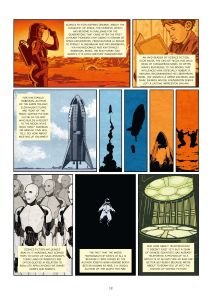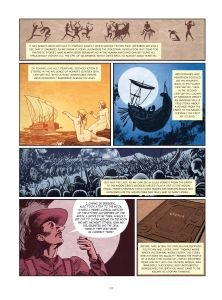The History Of Science Fiction: A Graphic Novel Adventure by Xavier Dollo and Djibril Morissette-Phan (graphic novel review).
I have to confess that when I was offered this book, ‘The History Of Science Fiction’, I was paying more attention to the title than its sub-title, ‘A Graphic Novel Adventure’. Getting it, it was more like in for a penny, in for a pound and I am supposed to know something about the history of Science Fiction. You’re just getting less text and more illustration as Robby the Robot and an unidentifiable robot consult an AI about the history of Science Fiction.
Seeing characters pop up in the opening pages, including ‘Star Wars’, I did ponder on their definition as that belongs to science fantasy. Oh, half-way through, this second robot is identified as Jenkins, a product of Clifford Simek’s story ‘Huddling Place’ (1944).

Xavier Dollo is the writer and Djibril Morissette-Phan is the artist and it must have been some hair-tearing moments, especially when it came to choosing particular film images for representation. The Nautilus used is from Disney’s ‘20,000 Leagues Under The Sea’ although the Martians war machines are based on the 3-limbed variety than the George Pal film. Paying attention to the art, it does become obvious that some character and writers drawings is limited to the few number of photographs available, more so as so many used were based on their elderly years than in their prime.
I’m not sure if I agree with them that Buck Rogers was the first place ray guns were used, only because E.E. ‘Doc’ Smith was there the same year, 1928, with The Skylark Of Space’ so probably a tough call who got in print or on screen first.

They do make a good point about author Ray Cummings (1887-1956) being forgotten but if we can work out how writers can be kept in the public eye after death, let me know. Check out any Golden Age authors you might not be familiar with and I’ve popped a Cummings novel in my to-read list. It also looks like Cummings was the first author to have someone living on an atom in several stories. Some of his books are out there so not entirely gone or forgotten although someone ought to do a proper collection. The same also applies to Stanley Weinbaum (1902-1935), sadly dying far too young.

Encompassing the entire history of Science Fiction in 200 pages is a tough call and some odd compromises. Seeing various writers with their full names given as opposed to how they are acknowledged in print is a little weird. Equally, AE Van Vogt didn’t like being called ‘Alfred’ but ‘Van’ and Theodore Sturgeon preferred ‘Ted’, although that is only used once. When you have these Golden Age writers sitting down together, that does cause a raised eyebrow although I suspect this is one of the compromises when having imaginary meetings. I’m surprised Cordwainer Smith wasn’t included here because they all respected his writing but does pop up further in.
Bearing in mind that Xavier Dollo is French and Van Vogt is very popular over there, I did wonder if he was being neglected with so many pages on Asimov but he successfully not only got a plug in for General Semantics but ‘World Of Null-A’ as well. There is also a lot of book acknowledgements so keep your notebook handy.
The history focuses mostly, outside of Jules Verne, on American and British Science Fiction and their influence. Michael Moorcock’s ‘New Worlds’ magazines and books mostly bypassed me although I was following John Carnell’s ‘New Writings In SF’ when I could find the anthologies locally when young. Science Fiction was sadly neglected or didn’t hae a wide enough variety in my local library and went through local shops until I could and visit bigger bookshops. The intermix of writers from both countries seeking work is interesting although it does seem commonplace when it happens today.

Oddly, the book becomes text heavy towards the end, no doubt with the realisation of how much more needed to be covered at the end. Although caps work wonders in dialogue in comicbooks, capped text would have made it easier to read switched to lower case.
The most telling thing at the end is pointing out how much space opera is going on today and there certainly needs more effort from publishers to not rely on agents so much to select stories and get new voices out there that will attract new ideas into our genre.
There are some notably absences. Despite using Judith Merril as a host for a sizable section, the number of female writers is down to one page and no biographies. You would think the likes of Anne McCaffrey and CJ Cherryh would deserve a better mention than that.

Although the TARDIS is used for time travel, without its top light, barely a mention of ‘Doctor Who’, although ‘The Twilight Zone’, ‘Outer Limits and ‘Star Trek’ doesn’t fare much better, although Rod Serling becomes one of the commentators. Acknowledging them is one thing but it’s hardly like they aren’t important in SF’s evolution.
Comicbooks get a mention, mostly regarding Superman but Marvel one mention, related to Conan, and not a hint at how the X-Men in the 1970s became so successful. You would have thought there might have been some acknowledgement of Science Fiction artists and their influence, especially in the pulp magazine era, but not a dicky bird. Considering how much a cover influences someone to buy a magazine or book this is sorely neglected.
Should I mention the Internet? Someone has to as they didn’t. Granted there are a lot of sources of SF on-line and it would be difficult to point out any breakout material, it has improved contact level between fans outside of conventions.
I don’t know who chose the paper and text colours but the small size on top of it makes the index very difficult to read and hardly fit for purpose.
Despite these large absences, this is an interpretation of the history of Science Fiction that could have done with a second volume and spread out more. It will undoubtedly give you a starting point for exploration to find out more and go into more depth. If you’ve been following my reviews over the years, you know there are more history SF books out there to deal with that. A visualisation like this is unique, though, and probably out there for the yuletide market.
GF Willmetts
November 2021
(pub: Humanoids, 2021. 200 page index graphic novel large hardback. Price: $29.99 (US). $39.99 (CAN). ISBN: 978-1-64337-914-3)
check out website: www.humanoids.com
